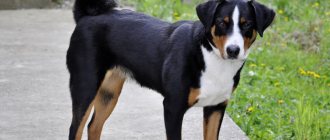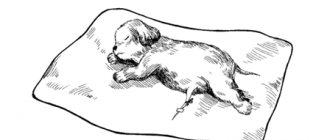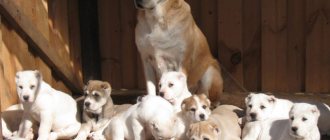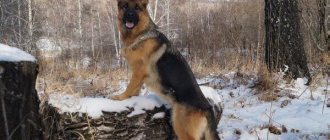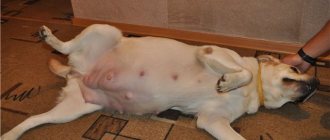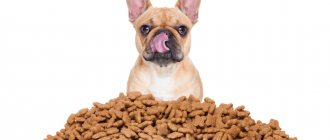Estrus in dogs (estrus, mating, heat) is a natural process, indicating that the female has matured physiologically. The onset of estrus is a signal that the bitch is ready for mating, and her reproductive system is fully formed. Owners of bitches must keep this process under control in order to promptly protect their dog from unwanted mating or organize a productive planned mating. What do all dog owners need to know about the estrus process? How does it go and how long does it take? How to help your pet? Why is my dog not in heat? What types of canine contraception exist? You will find answers to all these questions in our material.
When does a dog go into heat?
There is no exact time for the first estrous cycle (estrus) - each individual experiences the first estrus individually.
- Average age – 6-24 months.
- Small and miniature breeds – 6-9 months.
- Large and giant breeds – 13-24 months.
Owners do not always notice this phenomenon. For the first time, many animals experience a “hidden emptying”. The heat passes quickly, unnoticed, with minor discharge from the loop, which does not have time to attract the attention of the opposite sex. However, you cannot relax and let the situation take its course - mating and pregnancy may occur .
False heat
“False estrus” is a phenomenon when a young female shows external signs of estrus, but does not ovulate. This is not dangerous to the pet's health. Usually, a few days after the “false” one, real estrus occurs (with ovulation).
Important!
Estrus is not permission to breed. Veterinarians allow dogs that have reached 15 months of age. In the first cycle, mating is not carried out. The most successful mating period is the third cycle.
How many days does a dog go into heat?
The period of active sexual hunting lasts on average from 12 to 21 days. During this period, males react to the female. The female is receptive to the opposite sex for about half of this time - 9-10 days.
The length of this period varies widely among different breeds of dogs. But it can also vary greatly within a breed. There are bitches who go into heat for several days, and there are those in whom this period reaches 4 weeks. Each dog has this meaning individually.
As often happens
The frequency of estrus depends on several factors:
- dog breeds;
- age;
- conditions of its detention;
- size.
Thus, dogs that are kept outside usually bleed once a year in early spring. This is laid down by nature so that the dog has time to bear and give birth to offspring in the warm season. Estrus also occurs in dogs of “northern” breeds: Siberian husky, husky, Samoyed, Alaskan malamute, etc.
Pets usually bleed once in the fall, and again at the very end of winter. Miniature and small dog breeds go into heat twice a year. The interval between cycles is 6 months. In older bitches, the intervals between heats lengthen, and the signs become blurred, almost imperceptible.
We have already said that it is important to keep an estrus diary, noting each heat, in order to control this process . If the interval between cycles becomes too short (less than 4 months) or there is a significant delay (more than 9-10 months), you need to take the dog to the veterinarian. Such deviations from the norm may indicate the presence of hormonal problems and require treatment.
Sexual cycle in dogs
» Biovetlab.ru » Publications » Reproductive cycle in dogsFishing online store
There is a division of animals based on the rhythm of the sexual cycle into mono- and polycyclic. The first group includes animals with 1 sexual cycle per year. In polycyclic animals, several cycles occur, which are repeated with a certain frequency during the season or the whole year, depending on the type of animal. It is difficult to classify dogs into any particular of these groups, since they can have 1-2 or even 3 sexual cycles throughout the year. Therefore, some authors classify dogs as monocyclic, while others consider them dicyclic animals.
A number of signs prevail that indicate that dogs should be classified as monocyclic animals. For example, representatives of wildlife from the canine family (wild dogs Dingoes, wolves, jackals, coyotes) have only one sexual cycle per year and at a strictly defined time of year. And domestic dogs have a lot in common with them and can be crossed. In addition, females experience estrus after the aestrous period, which is also typical for monocyclic animals. The increase in the number of cycles in dogs and their independence from the seasons arose during the process of their domestication.
As a rule, the period of sexual activity of females is determined by the interestrous period. The fact is that establishing the duration of the reproductive cycle of dogs and the time of its completion is possible only with the use of laboratory research methods. To do this, the dynamics of the hormone progesterone in the blood and the nature of vaginal smears are analyzed. The duration of the interestrous period can be different and varies depending on the breed.
The duration of the interestrous period does not depend on pregnancy. The reproductive cycle of dogs is special and differs significantly from the cycle of other domestic and farm animals. Before the start of sexual heat, bitches develop hemorrhagic discharge resulting from diapedesis. When sexual heat occurs, an immature egg ovulates, which can be fertilized 2-3 days from the moment it enters the oviduct. By the end of sexual heat, an active corpus luteum is formed. Unlike dogs, in other animals the corpus luteum is formed at the end or after sexual heat, and a separate stage of the cycle is distinguished - metestrus (inhibition period). This is followed by a period of sexual rest - anestrus.
Thus, the reproductive cycle of dogs is divided into 4 phases, or stages:
- proestrus;
- estrus;
- diestrus;
- anestrus.
Let us consider each of these stages in more detail.
Proestrus ( precursor)
.
The duration of this phase is approximately 9 days. Its signs are bloody vaginal discharge and swelling of the vulva. Depending on the breed, the intensity of the discharge varies; it may not be noticeable at all if the dog licks it. Urination becomes more frequent. Towards the end of the phase, the bitch begins to attract males, but does not allow intercourse. At the same time, there is a small probability of ovulation, and a few days later - fertilization.
Estrus
Estrus, like pre-gestation, lasts approximately 9 days. During this period, the vulva becomes softer. The first sign of the onset of the phase is the individual’s readiness for intercourse. At the same time, the discharge becomes thinner and less abundant. This is typical only for those bitches who experienced intense discharge during the proestrus phase. As already mentioned, depending on the breed, dark-colored discharge may be slight and continue during the first three periods of the sexual cycle. Ovulation occurs either at the very beginning of estrus, or on days 2-4.
Metestrus
(diestrus)
The duration of diestrus is 60 days. The phase begins from the moment when the individual first rejected coitus. Swelling of the vulva gradually disappears, bleeding stops. Mucus discharge may appear.
Anestrus
The phase is characterized by a period of ovarian rest and continues until the beginning of the next proestrus. It is difficult to accurately determine the duration of anestrus, since it depends on the time of year, and on provocation by pheromones, when a female in heat is nearby, feeding conditions, housing and other factors. The stability of the intervals of the sexual cycle is maintained for 6 years, and then the duration of anestrus and the time interval between estrus increases.
Vaginal cytology
In proestrus, there is first an increase in the concentration of estradiol, which promotes cell division in the basal layers of the vaginal epithelium. Next, the concentration of this hormone decreases, and more dead cells are traced in the sample taken. As proestrus progresses, the number of epithelial cells containing the nucleus decreases. The smears reveal an increased concentration of red blood cells (up to the middle of proestrus). The peak formation of keratinized cells occurs along with an increase in the amount of the hormone progesterone, indicating the beginning of the fertile period.
Due to its simplicity and accessibility, this method remains the most popular for determining the reproductive status of a dog. The material for the study is taken using a long plastic or wooden stick with a cotton swab at the end, which is inserted deep into the vagina and a smear is taken. When collecting a sample, it is important to prevent the swab from coming into contact with the external genitalia, since the cells that enter will blur the cytological picture.
The resulting cells are placed on glass and then stained. There are two most popular methods. In the first case, the dead cells acquire an orange tint, and the active (containing nuclei), basal and parabasal epithelial cells become blue or green. In the second, the cells are stained in different colors of blue and blue, and the morphology of the cells is assessed.
By the end of estrus, spotting changes significantly. The nature of the changes is accompanied by the appearance of epithelial cells with poison and an increase in the number of leukocytes. These phenomena are observed 7-9 days after the LH peak and are designated “vaginal metestrus smear.”
It should be noted that vaginal cytology is a fairly informative method for establishing the phase of the estrous cycle. The use of the technique is limited due to significant time differences in the manifestation of the main signs of estrus and peak fertility.
Changes in the color intensity of vulvar discharge during estrus.
Start of heat end of heat
Anestrus Proestrus
Estrus Diestrus
Quantitative determination of progesterone (ovulation monitoring)
The concentration of progesterone in the blood begins to increase approximately 5 days before the onset of ovulation and exceeds the baseline concentration level by 3-6 or more times. Depending on the breed, the level of increase in concentration and growth rate will differ. Laboratory studies have found that during ovulation, the level of this hormone reaches an average of 5-10 ng/ml.
It is believed that artificial insemination or mating should be carried out within the next 48 hours from the onset of ovulation. In this case, the time of maturation of germ cells in bitches should be taken into account (2-3 days). Control mating is carried out 2 days after the first.
Accurate calculation of the moment and time of ovulation helps to increase the number of successful matings and the fertility of the female. A small litter, often attributed to the age of the dog, is most often caused by the wrong choice of moment for mating.
The simultaneous implementation of vaginal cytology and determination of progesterone concentration allows for a fairly complete and accurate observation of all stages of estrus and assists in increasing the number of puppies in the litter.
Pg: basal (
• ovulation has not yet begun;
• wait 3 or 5 days.
Pg: slight increase (1 - 3 ng/ml):
• ovulation will occur soon;
• next blood draw in 1 - 2 days.
Pg: reaches a value of 5 - 10 ng/ml: ovulation has occurred. Mating is possible in 1-2 days.
Veterinarian
Maria A. M.
RELATED PUBLICATIONS
Dirofilariasis in cats: symptoms, diagnosis, treatment
Dirofilariasis in cats is caused by the helminth Dirofilariaimmitis. Heartworm larvae are called microfilariae. Mosquitoes are the intermediate host. Canines are the definitive host, but cats and ferrets are also susceptible to the disease, and they rarely serve as sources of spread of the disease. Helminths are found in the pulmonary artery and right ventricle of the heart.
Transmissible venereal sarcoma in dogs: symptoms, diagnosis, treatment
Transmissible sarcoma (venereal sarcoma, Stieker's tumor) is a unique neoplasm found only in dogs. The tumor is transmitted from one individual to another through contact, most often during mating. For a long time, a viral etiology of this disease was assumed. It is now believed that transmission occurs due to mechanical transplantation of tumor cells. Russian oncologist Novinsky, working with transmissible (venereal) sarcoma, conducted the first successful experiments on tumor tissue transplantation.
THIS IS INTERESTING:
Signs and symptoms
The very first symptom that owners of bitches usually notice is bloody discharge from the vagina (loop). But, this discharge usually appears a few days after the start of estrus. The intensity of this discharge varies from dog to dog.
An attentive owner knows how to understand that his pet is going into heat before drops of blood appear. During this period, the dog’s hormonal levels change dramatically – this pushes the pet to behave more freely.
Signs that indicate your dog is in heat:
- Changes in behavior. The dog becomes more playful, nervous, active and stops obeying the owner. May become aggressive.
- The dog urinates more often. May urinate in inappropriate places. There is uncontrollable urination. Urine contains pheromones that attract male dogs.
- Appetite decreases or increases.
- Increase in body temperature by 0.5°C.
- The dog constantly whines and asks to go for a walk.
- A dog constantly sniffs while walking; it may seem like it is following a scent.
- During a walk, males show more attention to the dog. Bitches flirt with them.
- The vulva swells and produces blood. Characteristic bloody drops appear on the floor and bedding.
- An unpleasant odor appears in the dog's genital area.
- The dog constantly licks itself under its tail.
- Some dogs shed before going into heat.
In the first days of the estrous period, females do not allow male dogs to approach them, show aggression towards them, and may bite them. Their body is not yet ready for mating. After 10-15 days, the color and structure of the discharge changes - they become mucous and yellowish-transparent. The dog's loop during this period is significantly enlarged. During this period, the female is ready for mating; she stands in a position convenient for mating and moves her tail.
This most suitable time for mating lasts on average 5-7 days . The owner must closely monitor the dog and note any changes in the diary. This is necessary to carry out mating if the owner is interested in this or to prevent unwanted mating.
How long does a dog's pregnancy last?
The duration of pregnancy is much more predictable when the date of ovulation is known. In this case, labor will begin on days 62–64 from the day of ovulation.
A peculiarity of dogs is the discrepancy between the time of ovulation and the fertile period: this means that after ovulation the egg requires about 48 hours to mature and be fertilized, and 48–72 hours after maturation the eggs die. Spermatozoa, in turn, are able to survive in the reproductive tract for up to 7 days. Accordingly, if mating is carried out several days before ovulation, fertilization will occur much later, and the pregnancy will seem longer. If mating is carried out, for example, 3-4 days after ovulation, sperm will fertilize those eggs that have not yet undergone degeneration, and the pregnancy will seem shorter.
The choice of mating time can be based on clinical signs, the attractiveness of the bitch to male dogs and her acceptance of mating, the change in the nature of vaginal discharge (from intense hemorrhagic to lighter) and counting the days from the onset of estrus. Not all dogs' fertile period occurs between days 11 and 13 of heat, and for a large percentage it may vary from cycle to cycle.
The method of determining the fertile period by examining vaginal smears allows us to detect the presence of superficial cells of the vaginal epithelium, which appear in direct proportion to the increase in the level of estrogen hormones. Based on the results of a cytological examination of vaginal smears, it is possible to determine the signs of estrus - the very stage during which ovulation occurs, but it is impossible to determine the time when it occurs. This is an important method, but not accurate enough.
Subscribe to the newsletter and get a discount at the pet store “Lubimchik”
Thanks for subscribing!
Testing the level of the hormone progesterone in the blood is the most accurate method for determining the time of ovulation in dogs. Progesterone begins to rise even before ovulation, which allows you to start taking measurements early. Progesterone levels at the time of ovulation are approximately the same in most dogs. As a rule, several measurements are required (once every 1–4 days).
Ultrasound examination of the ovaries is another method that significantly increases the accuracy of determining the time of ovulation.
In practice, from the 4th–5th day of estrus, a cytological examination of vaginal smears should begin, then (from the moment the estrus pattern is detected in the smear), blood tests are carried out for the hormone progesterone and an ultrasound examination of the ovaries.
Make an appointment at one of the trusted clinics in Moscow and the Moscow region using the link.
How does estrus work in dogs?
Let's take a closer look at the entire estrous cycle of a dog; it consists of four phases (stages).
Stages of the estrous cycle:
- Proestrus (precursor) . The duration of the period is 7-15 days. On average - 9. The first signs of estrus appear. The vulva swells and begins to bleed. The dog often urinates, flirts with male dogs, but does not allow them to approach him. The dog becomes nervous, active, and stops following commands. During this period, the follicles develop, estrogen levels rise to a maximum, but ovulation has not yet occurred. The bitch is not ready for mating.
- Estrus (sexual hunting) . The egg matures and is released from the ovary. The female becomes favorable towards males. The period is ideal for mating. It lasts on average 9 days, but in different individuals it can last from 4 to 24 days. In the first days of estrus, the bitch may not allow male dogs to approach her. But, after a while, she herself looks for mating, lifts her tail, stands in a position convenient for mating, and waits for a male. The vulva is still enlarged, but softer. Discharge from the loop becomes less colored and mucous. The dog's hormonal background changes - estrogen levels drop, and progesterone increases.
- Metaestrus (interestrus, diestrus) . Sexual hunting ends, the uterus returns to its natural state. In place of the burst follicle, the corpus luteum develops, the level of progesterone increases, and the uterus is waiting for the embryo. Females lose interest in the opposite sex. The duration of the period is from 60 to 90 days. Pregnancy or “false pregnancy” is possible.
- Anestrus (rest) . Occurs in the absence of fertilization. Duration – 3-5 months. The bitch's body rests and recovers before a new cycle.
Important!
Owners of show-class pets should not allow dogs in heat to attend shows - this will distract other exhibitors.
How to determine ovulation at home
You can pat the dog on the lower back (closer to the croup) - if it freezes and moves its tail to the side, it is ready for mating.
Also, if you press the bottom of the loop, the dog will stand motionless and move its tail - a clear sign of the beginning of ovulation.
Laboratory tests are the most accurate, although they do not give 100% results. You can try to determine ovulation at home. After all, who can know better about the dog’s behavior than the owner?
It is not so easy to determine without available means, because these days can shift throughout life. I can give you tips that may help you.
In order to be able to determine the process of ovulation, you need to place the dog during estrus on a white sheet. Then you will notice changes in the color of the discharge. The stain left on the fabric was divided into two circles according to color. It's darker inside, but lighter around the edges.
But these methods cannot give a guarantee, because ovulation in some dogs occurs in a couple of hours; roughly speaking, you can simply skip such a moment.
Don’t be upset, you can do without visiting a veterinarian, but for this you need to purchase special tools and then you will not miss the moment.
According to statistics, 80% of dogs that remained infertile after mating were mated at the wrong time.
You can determine ovulation in dogs even at home
- Ovulation in dogs is usually determined by a blood test. But this process can also be recognized by the animal’s saliva - the ARBOR device (test microscope) will help you. Due to the fact that during the period of ovulation, estrogen in the blood increases, as a result of which the shape of the crystals in saliva changes - they become like a fern leaf.
- A good option would be Uriglyuk-1 Test Strips , they are intended for diabetics. (There are 50 pieces in a package.) You can catch a drop of discharge on the strip in the yellow sector, after which you need to close the jar and wait. If the color has not changed, the ovulation period has not yet begun; the good thing about the test is that it can be performed at any time.
- To determine the most accurate result at home, the Probe device . It is easy to use and does not cause any discomfort in the animal; veterinarians use it without resorting to testing. The device is inserted into the animal's vulva and the results are recorded. You can follow the changes.
How to help a dog in heat
The owner of a bitch should know what he can do for his dog during this difficult period for her. Be able to protect her from unwanted activity of male dogs, know methods of contraception, and help with mating.
The owner should devote more time and attention to the dog during this period . You need to talk to her more, show tenderness, and comb her. It is important to spend more time with your pet, initiate active games, and take more walks in places where there are no crowds of dogs. Run with it, throw away a stick or Frisbee - this will help you release pent-up energy and relax. For the same purpose, you can use sedatives from a veterinary pharmacy.
Anti-estrus medications
There are two types of drugs used in veterinary medicine:
- hormonal, disrupting estrus;
- non-hormonal, reducing the pet’s libido and arousal.
Hormonal drugs to stop estrus
Drugs in this group interrupt and prevent estrus. But, they cannot be used uncontrollably and constantly, like contraceptives. Only a veterinarian should prescribe hormonal medications. They are introduced according to the scheme. Once the drugs wear off, dogs go through a natural estrous cycle. These products are not an alternative to sterilization. They are used with caution due to the high risk of complications .
This method of reversible contraception is recommended for use in isolated cases when the estrous cycle falls at an inconvenient time for the owners. Most often it is done to dogs during foster care, before exhibitions, competitions or while traveling. Sometimes hormonal drugs are prescribed for medicinal purposes. Hormonal drugs are not used if estrus has already occurred.
Drugs that stop estrus:
- Kovinar (Netherlands). Injectable contraceptive to prevent estrus and treat false pregnancy. The active ingredient of the drug (prolygestone) is a steroid hormone. This substance suppresses the production of sex hormones in the bitch. Price: 20 ml. – from 1800 to 2200 rub.
- Sex Control (Russia). Domestic contraceptive in tablets and drops. The active ingredient of the drug is the hormonal substance megestrol acetate. Prescribed to female dogs to delay and interrupt estrus. Prescribed by a veterinarian. Dosage is calculated by weight. Course admission required. Price: pack of 10 tablets. – 120 rub.; drops 5 ml. – 115 rub.
- Sex Barrier (Russia). A drug with a contraceptive effect. Available in drops and tablet form. Interrupts sexual heat and normalizes the dog's behavior. Price: pack of 10 tablets. – 170 rub.; drops 3 ml. – 245 rub.
- Stop Intimate Api San (Russia). Hormonal agent for regulating sexual desire. Available in tablet form. It is given orally to female dogs to delay or interrupt estrus. Price: pack of 12 tablets. – 190 rub.
- CounterSex Neo (Russia). Veterinary contraceptive pills and drops. Inhibits reproductive function, regulates sexual desire. Use orally as prescribed by a veterinarian. Price: bottle 2 ml. – 128 rub., pack of 10 tablets. – 77 rub.
- EKS-5 and EKS-7.5 (Russia). An effective remedy for suppressing ovulation, correcting behavior and suppressing sexual desire. The composition of the drugs is identical, differing only in the dosage of the active substance (megestrol acetate). Price: 5 ml bottle. – 280 rub., pack of 10 tablets. – 105 rub.
- Pillkan 5 (France). A drug with an antiovulation effect is prescribed for a one-time cessation of estrus or its delay. Has a hormonal basis. Available in the form of sugar cubes, which are dissolved in food or water or given by hand. Price: pack 8 cu. – 550 rub.
- Ovostop (Russia). The new generation contraceptive is available in the form of drops on the withers in pipettes. Suppresses the onset of ovulation, corrects behavior. Price: pack 2 pip. – 315 rub.
Contraindications
Like all hormonal drugs, contraceptives for dogs have contraindications:
- Lactation period.
- Pregnancy.
- Neoplasms (benign and malignant).
- Diabetes.
- Pathologies of the genitourinary system.
- Urolithiasis disease.
- First heat.
- Diseases of the mammary glands and genital organs.
- Concomitant use with corticosteroids is prohibited.
Side effect of hormonal drugs
You need to take hormonal contraceptives according to the regimen prescribed by your veterinarian. During treatment, the dog must be shown to a doctor in order to determine therapeutic effectiveness and timely detection of side effects.
- Swelling of the mammary glands.
- Lethargy and apathy.
- Increased appetite.
- Obesity.
- Development of pathologies of the genital area.
- Decreased immunity to sexually transmitted infections.
Important!
It is unacceptable to give dogs drugs of this group, based on reviews from owners and data from free sources. Hormonal medications should be prescribed by a veterinarian.
Drops, tablets and suspensions to reduce sexual arousal
Drugs in this group do not stop estrus. They reduce the dog’s emotional arousal and help the animal survive this period more easily and calmly.
Means to reduce sexual arousal:
- Hormone Balancer Flower Essence Drops (Australia). The best herbal preparation for eliminating behavioral disorders of a hormonal nature: estrus, false pregnancy, postpartum condition. Price: bottle 25 ml. – 2700 rub.
- Da-ba Relax Plus (Latvia). A sedative improves the functioning of the nervous system. Helps the dog survive stress during estrus. Price: pack of 30 tablets. – 450 rub.
- Stop Stress Api San (Russia). Drops to reduce sexual arousal and correct dog behavior. Price: bottle 15 ml. – 260 rub.
How to discourage male dogs from the current female
To reduce the interest of male dogs in a walking bitch, you can use veterinary agents to neutralize the odor.
Remedies to reduce the interest of male dogs during heat:
- Canina Dog-Stop Spray (Germany). The spray is sprayed onto the dog's backside, tail and thighs. Repeat the treatment twice a day: morning and evening. The spray effectively stops the odor emanating from a female dog in heat. Stops unwanted advances from male dogs. Price: bottle 100 ml. – 1050 rub.
- Antikobelin. (Russia). Deodorizing spray that removes the smell of bitches in heat. Twice a day you need to treat the dog's tail, hind legs, and perineum. Price: bottle 150 ml. – 180 rub.
- DOG STOP FORTE (Germany). Dragee to reduce the specific odor of a bitch during heat. Herbal preparation. During estrus, daily intake is necessary. Price: pack of 60 tablets – 1200 rub.
Important!
If you do not have the opportunity to buy drugs to neutralize the smell of the bitch, use a proven folk remedy - a concentrated decoction of bay leaves. You can use any eau de parfum for the same purpose.
Features of caring for a bitch in heat
During their first heat, dogs may not be careful and leave bloody spots everywhere. If the dog does not lick itself thoroughly, you can put on special hygiene panties for the first time. They resemble baby panties and are sold in pet stores. But you shouldn’t abuse wearing panties - it’s important that the dog immediately gets used to licking itself. For the same purpose, it is recommended to remove carpets in the house.
Features of caring for a dog during heat:
- Walk your dog on a leash throughout the entire period of heat. It is advisable to abandon the roulette leash at this time and switch to a short leash.
- Walk in places where there are no males or other females. Females become aggressive and may behave inappropriately towards dogs of both sexes.
- Limit walking outside in cold weather. The current bitch's body is susceptible to hypothermia and infections.
- Do not allow your dog to swim in ponds. During the period of estrus, the animal's vulnerability to the genitourinary system increases.
- You cannot approach male dogs even on a leash. Mating can happen in a matter of seconds.
How to ensure cleanliness
The issue of hygiene is one of the most important during the estrous cycle. A walking female will leave blood stains on the floor, furniture, and carpets. What should owners do to ensure cleanliness?
- Remove all fabric and carpeting from the floor.
- Cover all the upholstered furniture on which the dog is used to lying and sleeping with old towels or blankets. There is no need to drive the dog away from these places - this will negatively affect its psyche.
- Carry out daily wet cleaning. It is advisable to remove stains as they arise.
- Use special underpants for dogs.
Briefs for heat
The pet industry offers many models of pet panties of varying quality and size. Panties help keep the house clean and protect the animal from bacteria and infections. The product is convenient because it can be worn at home, on a walk, or while traveling on public transport. Wearing underpants during emptying is especially important for pets sleeping in the owner's bed.
Types of panties:
- disposable (diapers);
- reusable fabric (with a pocket for padding).
pros:
- protect furniture and floor surfaces from stains;
- interfere with random mating;
- protect against infections and bacteria.
Minuses:
- cannot be worn constantly;
- not all pets can relieve themselves in them;
- dogs may experience discomfort.
Signs of the onset of ovulation
The reproductive cycle of a female dog is purely individual.
The main symptom is a change in the color of the discharge (lightens) and its quantity (decreases). The condition of the vulva changes (swells and falls) - this is quite noticeable. The bitch pulls the loop up and moves her tail away. When stroking the rump it freezes.
The dog becomes more active, you can notice how it explores the territory or leaves marks. She becomes more interested in the street than at home. When a male dog approaches, he takes a stance. General changes in behavior, constant wakefulness or increased appetite, depending on individual characteristics.
When a dog approaches, the bitch stands up
What to do if your dog doesn't want to mate
If your plans include breeding, find out what to do if the dog does not want to mate.
The first piece of advice is to contact a kennel club or professional breeders. There are knitting instructors there. The specialist will explain how you can help the dog or do everything himself.
The owner can independently help his girl like this:
- Choose the right day for mating.
- Put a muzzle on your dog or tie a scarf over its muzzle.
- Place your thigh under the bitch's belly and turn her towards the dog. Hold your dog by the collar.
- Secure the dog and tuck its muzzle under your armpit.
- Help the male dog during boarding. You can lift the loop by placing your hand under the dog's belly.
FAQ
On what day of heat should a dog be bred?
This indicator is individual for each individual. The optimal period is considered to be 9-13 days. Breeders keep a calendar and calculate the best day for mating empirically.
Is it possible to spay a dog during heat or should I wait until it is over?
There is no clear answer to this question. This should be answered by a veterinarian. The doctor must take into account the dog’s health status and the presence of medical contraindications.
Can a dog get pregnant without being in heat?
Of course not. A pregnancy that is unexpected for the animal’s owners is the result of an estrus that went unnoticed.
What should you do if your dog has swollen mammary glands after estrus?
Immediately show the animal to the doctor, he will be able to make a diagnosis. A symptom usually has two causes. The first is that fertilization has passed and pregnancy has occurred. The second is false pupishness.
How many times do dogs come into heat per year? What frequency is considered normal?
In veterinary medicine, a frequency of 1-2 times a year is considered conventionally normal. The indicator is individual.
Do spayed dogs go into heat?
If a sterilization operation is performed (without removing the reproductive organs), then the dog remains in estrus. If castration (ovariohysterectomy or ovariectomy) was performed, there should be no heat. The presence of bloody discharge after castration is a bad sign.
Until what age do dogs go into heat? At what age does this process stop?
Dogs do not have menopause; the estrous cycle continues throughout their lives. But, veterinarians and professional breeders believe that all dogs over 7 years of age must be sterilized with complete removal of the uterus and ovaries. Pregnancy and childbirth in dogs older than 7 years is a big risk and burden on the animal’s body.
We have a Labrador Retriever. The girl is not sterilized. The last heat was a little over a year ago. Why hasn't my dog been in heat for a year?
You did not specify the age of the pet. In older pets (over 8 years old), estrus may occur less frequently and less intensely. A delay in young females indicates problems.
Is it possible to worm a dog during heat?
You can deworm and treat for external parasites without any restrictions. The only thing that cannot be done is vaccination.
Is it possible to wash a dog during heat?
There are two opinions on this matter. Some veterinarians believe that water procedures are completely contraindicated. The latter do not see the need to refuse the owners. They allow pets to be bathed. The only thing they are unanimous about is that you shouldn’t let your dog into open, cold water. There is a risk of infection and inflammation of the genitourinary system.
How to walk a bitch during heat?
The frequency of walking does not change. Where there are no or few other dogs. The leash is short. Excessive physical activity is not allowed. Before going outside, it is recommended to treat your dog with a spray that neutralizes the smell of a female dog in heat.
What to do if your dog doesn't eat after being in heat?
Lack of appetite after estrus may indicate serious problems with the reproductive system. Be sure to take your dog to the vet.
Does your dog have white discharge after being in heat? What to do?
White discharge, discharge of any other color (brown, green) is an indication for a visit to the veterinary clinic. Call a specialist immediately to your home if the discharge has a strong odor.
What time of year is it most common for dogs to go into heat?
Street pets usually go for walks with the arrival of spring. There is no such pattern for pets.
